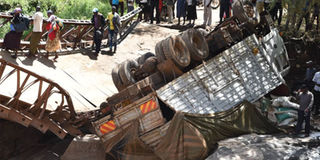Institutionalise disaster risk management

Muruny Bridge in West Pokot County collapsed under the weight of a truck that was transporting sugar on November 27, 2019. To protect life and offer disaster relief is the core mandate of government. PHOTO | FILE | NATION MEDIA GROUP
What you need to know:
- The government should foster the adoption and equipping of disaster management units at all levels with requisite human resource.
- The government must encourage disaster preparedness among the citizenry — as an agenda for all county governments, with adequate financing.
The ongoing rains have opened the Pandora’s box of how pitiably our disaster risk management structures are controlled and managed. The cyclic risk of floods and droughts often leave a bad taste in the mouth.
The response to the ongoing flooding has proved to be a disjointed effort that lacks coordination and is marred by political intrigues where politicians want to amass leverage through sympathy.
Why can’t the national and county governments anticipate and respond to disasters or Parliament enact a national disaster management law to help us leverage on disaster coordination and financing?
The legislation would ensure that disaster risk management and associated finances are better coordinated with a no-regrets approach, especially for the government (but it rarely has room for regret).
It would offer counties an opportunity to be the first responders, as stipulated by the Constitution.
CITIZENS' SAFETY
It is petrifying to see on social media an image of first responding officers hitchhiking on the backs of residents to cross a swollen river. Shouldn’t the reverse be true?
A disaster management colleague notes that failure to enact disaster risk management legislation seven years down the line has denied counties the much-needed funds for planning, response and recovery.
This is despite the national government guidance on county fiscal planning. Worse, the few county allocations are not made public.
This basically means that counties cannot operationalise funds for disaster response except through reprogramming of development funds.
This in itself take ages to achieve through bureaucratic approval processes. Moreover, reprogramming often puts accountability in question.
Our response is, habitually, a knee-jerk reaction. I call on the county governments to learn from past disaster response and plan to build back better as the Constitution underscores this as an intrinsic responsibility of both the national and county governments.
To protect life and offer disaster relief is the core mandate of government.
AID FOR VICTIMS
Using the recent West Pokot landslide tragedy as an example, the immediate needs for the victims should have been dignified shelter, food and clothing.
However, 72 hours down the line, it had turned out to be a political catwalk.
It is commendable how the government has done the search, rescue, reunification and triage of the operation.
However, the basic needs of the survivors need to be addressed as there is a thin line between sympathising and parading political muscle as opposed to taking leadership.
Were it an incident affecting high-flying compatriots, psychological first aid would have been in the offing for affected families; why not give the same treatment to the West Pokot survivors? The trauma is too great.
There is a need to standardise response for disasters by sea, land and air as they will always happen.
PRACTICAL SOLUTIONS
The government should foster the adoption and equipping of disaster management units at all levels with requisite human resource.
Disasters will keep happening; the difference is how prepared we are for them.
Finally, for risk aversion to be a reality, our forecasting should be more localised and actionable.
The government must encourage disaster preparedness among the citizenry — as an agenda for all county governments, with adequate financing.
Mr Magoma is a disaster risk management specialist. [email protected]




